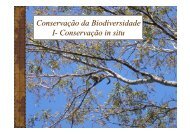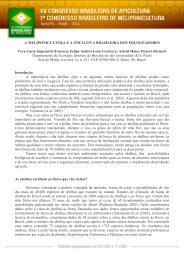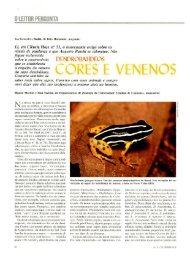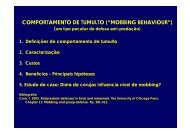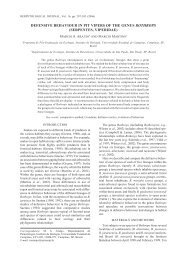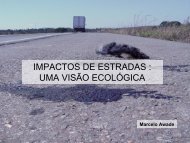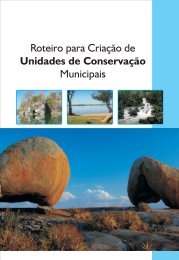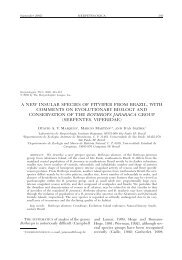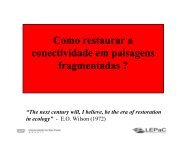Pulsed mass recruitment by a stingless bee, Trigona hyalinata
Pulsed mass recruitment by a stingless bee, Trigona hyalinata
Pulsed mass recruitment by a stingless bee, Trigona hyalinata
You also want an ePaper? Increase the reach of your titles
YUMPU automatically turns print PDFs into web optimized ePapers that Google loves.
2192 J. C. Nieh and others Stingless <strong>bee</strong> pulsed <strong>mass</strong> <strong>recruitment</strong><br />
sucrose solution (100 m l of anise extract per litre of solution,<br />
McCormick & Co. Inc.) located 146 m SW of the nest (method<br />
of von Frisch 1967). The control and experimental feeders were<br />
identical and contained the same quantities of scented 2.5 M<br />
sucrose solution. However, we immediately captured all <strong>bee</strong>s<br />
landing on the control feeder to eliminate <strong>recruitment</strong> to the<br />
control feeder. We marked each visiting <strong>bee</strong> with an individual<br />
combination of paint marks on the thorax. We monitored the<br />
visiting foragers each 15 min and allowed only 10 individually<br />
marked foragers to feed. We captured all other foragers with<br />
aspirators and did not release them. Thus foragers were not multiply<br />
counted.<br />
A newcomer is a forager from the subject colony who has not<br />
previously visited any feeder (Biesmeijer & de Vries 2001). To<br />
determine whether foragers visiting the feeder came from the<br />
subject colony and were motivated <strong>by</strong> recruiters to find the food<br />
source, we counted the number of newcomers arriving after we<br />
eliminated <strong>recruitment</strong> <strong>by</strong> capturing all foragers. We conducted<br />
three hour-long control trials on three separate days.<br />
Stingless <strong>bee</strong>s deposit odour trails <strong>by</strong> preferentially placing<br />
odour marks on prominent leaves elevated above the substrate.<br />
They will also odour mark leaves placed on an elevated rope,<br />
creating a trail with odour marks spaced along the rope, as they<br />
are on a natural substrate (Lindauer & Kerr 1958; Kerr et al.<br />
1963). To study the odour trail, we therefore attached a 100 m<br />
rope leading from the feeder towards the nest and fastened<br />
leaves at 1 m intervals along the rope (method of Lindauer &<br />
Kerr 1960). We attached leaves at 1 m intervals to all ropes used<br />
in our experiments. This technique allows one to move <strong>stingless</strong><br />
<strong>bee</strong> pheromone trails <strong>by</strong> shifting the location of the rope.<br />
Observers followed odour-marking <strong>bee</strong>s and recorded mark<br />
locations to the nearest 0.5 m.<br />
To analyse marking behaviour in detail, we digitally videotaped<br />
foragers depositing odour marks on a leaf attached to the<br />
feeder, and analysed the video (30 frames s 2 1 ) on a Macintosh<br />
iBook computer with iMovie software.<br />
(b) Testing the attractiveness of odour marks<br />
deposited on the resource<br />
We tested the attractiveness of putative odour marks in a<br />
paired-feeder assay. We offered newcomers a choice between<br />
two identical clean feeders. Around each feeder, we placed a<br />
ring of filter paper: one paper that had <strong>bee</strong>n putatively marked<br />
<strong>by</strong> foragers for 60 min, and one that foragers had not contacted.<br />
We placed feeders 1 m to the right and to the left of the original<br />
feeding site and captured <strong>bee</strong>s as soon as they landed. During<br />
odour bioassays, we immediately captured all <strong>bee</strong>s as soon as<br />
they landed on a feeder and only counted individual choices<br />
made in the absence of other <strong>bee</strong>s. We exchanged the control<br />
and experimental feeder positions at 1 min intervals to eliminate<br />
site bias (total trial time of 5 min) and discontinued the bioassays<br />
when the wind direction was not parallel to the feederto-nest<br />
axis and thus could have biased foragers to visit one<br />
feeder over the other. During the trials, such wind conditions<br />
occurred twice for intervals of ca. 15 min each.<br />
(c) Testing the attractiveness of the odour trail<br />
To test the attractiveness of the odour trail, we performed<br />
a V-shaped rope experiment with the leaf-bedecked ropes. We<br />
attached one end of a 50 m rope (the nest-proximal end) to a<br />
tripod 96 m from the nest. We attached the distal end of the<br />
rope to a feeder 146 m from the nest. The rope pointed directly<br />
towards the nest. In the odour-collection phase, we allowed for-<br />
agers to odour-mark the rope for 30 min. In the test phase, we<br />
removed the original training feeder, sealed it inside a plastic<br />
bag, and set out two identical, clean feeders, 10 m to the left<br />
and right of the training location. We then moved the distal end<br />
of the marked rope to one of the clean feeders and attached an<br />
identical but unmarked rope to the other clean feeder. We<br />
attached the proximal ends of both ropes to the same tripod and<br />
thus formed a V-shaped rope array. We alternated the position<br />
of the marked rope from trial to trial.<br />
(d) The spatial distribution of odour marks<br />
To determine the spatial distribution of odour marks, we<br />
intersected two perpendicular crossed ropes at the training<br />
feeder. From the feeder, the ropes extended for 100 m in the<br />
direction of the nest, 20 m in the other three directions. Three<br />
observers recorded the location and sequence of all odour marks<br />
deposited on the ropes to an accuracy of 0.5 m.<br />
(e) Testing the polarity of the odour trail<br />
We tested newcomer orientation within the trail <strong>by</strong> providing<br />
a choice between the training feeder and an identical control<br />
feeder located within the trail but 20 m closer to the nest. The<br />
trail extended 27 m away from the feeder in the direction of the<br />
nest, as determined <strong>by</strong> the maximum extent of odour marking<br />
on the rope (see § 3).<br />
(f ) Testing mandibular gland extracts<br />
Several <strong>stingless</strong> <strong>bee</strong> species use mandibular gland pheromone<br />
to odour-mark food sources and to create odour trails (Kerr et<br />
al. 1963; Blum et al. 1970). We observed T. <strong>hyalinata</strong> foragers<br />
appearing to odour-mark <strong>by</strong> briefly landing and rubbing their<br />
mandibles against the substrate. We therefore extracted and<br />
tested the attractiveness of T. <strong>hyalinata</strong> mandibular gland pheromone.<br />
We prepared extracts <strong>by</strong> using plastic bags to carefully capture<br />
non-alarmed foragers leaving the feeder, chilling the <strong>bee</strong>s, and<br />
dissecting out the mandibular glands. We crushed three glands<br />
in 1.5 ml of hexane (to standardize extract concentration), and<br />
stored 0.5 ml of the extract in a sealed centrifuge vial at 220 °C<br />
until the beginning of the bioassay, when we attached and<br />
opened the tube on the side of a feeder. Control vials contained<br />
0.5 ml of hexane and were handled and stored in the same way,<br />
but did not contain mandibular gland pheromone.<br />
During the collection and test phases, we used two clean forceps,<br />
one to handle the test filter paper and one to handle the<br />
control filter paper. We kept a supply of several clean glass feeders<br />
on hand. Once used, we washed the forceps and test feeders<br />
in a strong detergent, rinsing thoroughly with hot water followed<br />
<strong>by</strong> two washes of 95% ethanol. We air-dried all apparatus for<br />
at least 3 h before reuse. Even without washing, this time-interval<br />
is more than sufficient for any odour marks to completely<br />
evaporate (see figure 4). The experimenter wore disposable latex<br />
gloves during all feeder choice experiments and while washing<br />
glassware. After each trial, we discarded the gloves and all paper<br />
and plastic items used in the trial.<br />
(g) Statistical analyses<br />
We use the x 2 -test to determine the significance of the <strong>recruitment</strong><br />
control trials. In two-feeder experiments, we calculate<br />
probabilities from a two-tailed binomial distribution with<br />
p = q = 0.5.<br />
Proc. R. Soc. Lond. B (2003)




